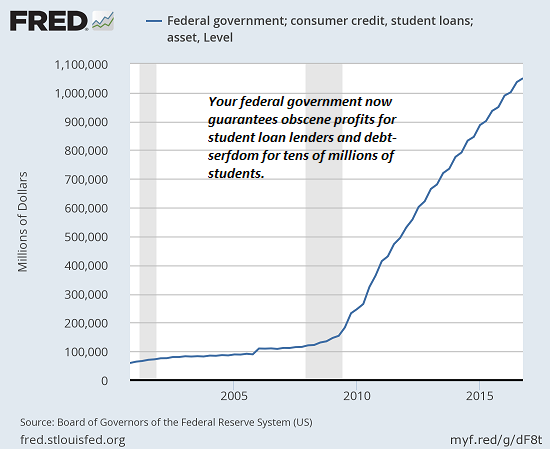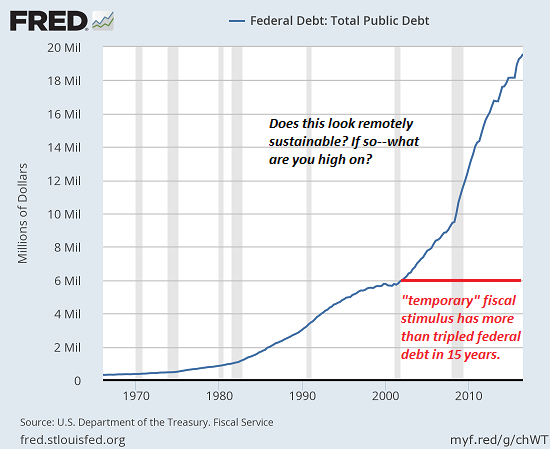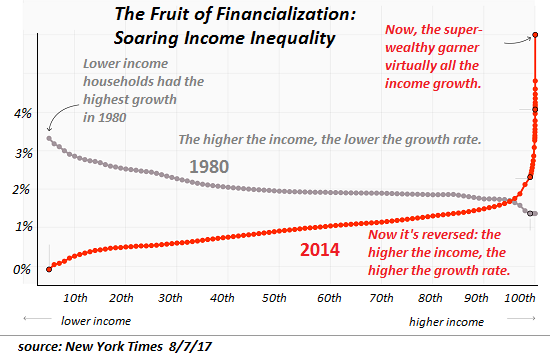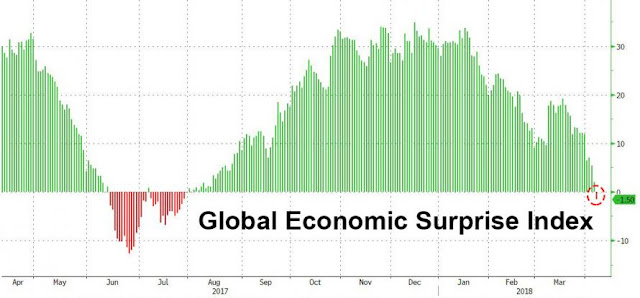After Trump ordered the USTR to consider an additional $100BN in tariffs, something we said on Wednesday would happen if the market was dumb enough to allow Trump to think he had a trade war victory by closing green…
…China has suddenly found itself in a quandary: as we showed first thing this morning, if Beijing were to continue responding to the US in a “tit-for-tat”, it would be unable to retaliate to the latest Trump salvo of a total $150 billion in tariffs for the simple reason that the US does not export $150 billion in products to China.
Which doesn’t mean that China is out of options; quite the contrary. The problem is that virtually everything and anything else that Beijing can do, would be a significant escalation. In fact, the five most frequently cited options are all considered “nuclear” and would promptly lead to an even more aggressive response from Washington.
Here are the five “nuclear” options that China is currently contemplating:
- A Currency Depreciation. A sharp, one-time yuan devaluation, like the one Beijing unexpectedly carried out in August 2015, could be used to offset some of the effect of tariffs.
- Sales of US Treasurys. Chinese authorities could sell some of its large official-sector holdings of US Treasuries, which would lead to a tightening of US financial conditions.
- Block US services. Chinese authorities could limit access for US companies to the Chinese domestic market, particularly in the services sector, where the US exports $56 billion in services annually and runs a $38 billion surplus
- Curb US oil shipments. According to Petromatrix, China is one of the biggest importers of U.S. crude oil at 400kb/d, so any counter-tariffs on crude could become very heavy for the U.S. supply and demand picture. Such a move would weigh on U.S. prices and spill over to global oil pricing. As Petromatrix adds, the market would need to start balancing downward price risk of trade-war escalations with upside risk of Iran sanctions as oil flows could be about the same.
In October 1973, the world shuddered when the Arab members of the Organization of Petroleum Exporting Countries imposed an oil embargo on the United States and other nations that provided military aid to Israel in the Yom Kippur war. At the same time, they ramped up prices. The United States realized it was dependent on imported oil — and much of that came from the Middle East, with Saudi Arabia the big swing producer. It shook the nation. How had a few foreign powers put a noose around the neck of the world’s largest economy?
Well, it could happen again and very soon. The commodity that could bring us to our knees isn’t oil, but rather a group of elements known as rare earths, falling between 21 and 71 on the periodic table.
This time, just one country is holding the noose: China.
China controls the world’s production and distribution of rare earths. It produces more than 92 percent of them and holds the world in its hand when it comes to the future of almost anything in high technology.
Rare earths are great multipliers and the heaviest are the most valuable. They make the things we take for granted, from the small motors in automobiles to the wind turbines that are revolutionizing the production of electricity, many times more efficient. For example, rare earths increase a conventional magnet’s power by at least fivefold. They are the new oil.
Rare earths are also at work in cell phones and computers. Fighter jets and smart weapons, like cruise missiles, rely on them. In national defense, there is no substitute and no other supply source available.
Today, The Week‘s Jeff Spross picks up on this topic, and in an article “How China can win a trade war in 1 move” writes that “if things do spiral into all-out trade war, it’s worth noting China has a nuclear option. I’m referring to rare earth metals.”
These are elements like dysprosium, neodymium, gadolinium, and ytterbium. They aren’t actually rare, but they do play crucial roles in everything from smart phones to electric car motors, hard drives, wind turbines, military radar, smart bombs, laser guidance, and more. They’re also quite difficult to mine and process.
Some more details, and the reason why none of this is new to those who have been following the rare earth space and China’s brief trade war with Japan back in 2010/2011:
Basically, if China really wanted to mess with America, it could just clamp down on these exports. That would throw a massive wrench into America’s supply chain for high-tech consumer products, not to mention much of our military’s advanced weapons systems.
In fact, China isn’t just America’s major supplier of rare earth metals; it’s the rest of the globe’s major supplier as well. And in 2009, China began significantly clamping down on its rare metal exports. Once, China briefly cut Japan off entirely after an international incident involving a collision between two ships. This all eventually led to a 2014 World Trade Organization spat, with America, Japan, and other countries on one side, and China on the other.
How did we get to this position where China has a near monopoly on rare earths:
Much of the story centers around Magnequench, an American company that emerged out of General Motors in the 1980s. It specialized in the magnets that account for most of the final components created from rare earth metals. But in 1995 Magnequench was bought out by a consortium that included two Chinese firms who took a controlling 62 percent majority share in the company. They also bought a big rare earth magnet plant in Indiana. Eventually, Magneuquench’s manufacturing capacities were moved to China, and the Indiana plant was shut down.
Executive branch regulators do wield power over foreign investment in and buyouts of American companies, particularly through the Committee on Foreign Investment in the U.S. (CFIUS). But this was the post-Cold War 1990s, when optimistic enthusiasm for globalized free market trade was at a peak. CFIUS approved the initial takeover of Magnequench in 1995 under the Clinton administration, as well as the later shutdown of the Indiana plant in 2003 under the Bush administration.
Lawmakers and the Government Accountability Office criticized the agency and both administrations for their lackadaisical approach to the issue. Hillary Clinton even struck a rather Trump-ian note in 2008, trying to turn Magequench’s sale to China into a campaign issue. But it was a tricky topic, given how her husband’s administration got the ball rolling. So rare earth metals have occasionally turned into a political hot potato, but usually for only brief periods.
Which then takes us back to our August preview of precisely where we are today:
At present, the rare earths threat from China is serious but not critical. If President Donald Trump — apparently encouraged by his trade adviser Peter Navarro, and his policy adviser Steve Bannon — is contemplating a trade war with China, rare earths are China’s most potent weapon.
A trade war moves the rare earths threat from existential to immediate.
In a strange regulatory twist the United States, and most of the world, won’t be able to open rare earths mines without legislation and an international treaty modification. Rare earths are often found in conjunction with thorium, a mildly radioactive metal, which occurs in nature and doesn’t represent any kind of threat.
However, it’s a large regulatory problem. The Nuclear Regulatory Commission and the International Atomic Energy Agency have defined thorium as a nuclear “source material” that requires special disposition. Until these classifications, thorium was disposed of along with other mine tailings. Now it has to be separated and collected. Essentially until a new regime for thorium is found, including thorium-powered reactors, the mining of rare earths will be uneconomic in the United States and other nuclear non-proliferation treaty countries.
Congress needs to look into this urgently, ideally before Trump’s trade war gets going, according to several sources familiar with the crisis. A thorium reactor was developed in the 1960s at the Oak Ridge National Laboratory in Tennessee. While it’s regarded by many nuclear scientists as a superior technology, only Canada and China are pursuing it at present.
Meanwhile, future disruptions from China won’t necessarily be in the markets. It could be in the obscure but vital commodities known as rare earths: China’s not quite secret weapon.
Of course, there is no way of knowing if China will proceed with a rare earth export ban as its response, or whether it will pick any of these options. However, for those who are growing concerned – or convinced – that it’s only going to get worse from here, there is good news: the VanEck Rare Earth ETF REMX makes it easy to make a substantial profit from the first nuclear trade war, should China clamp down on rare earth metals, sending their price to where they traded when China waged a brief trade war with Japan in 2011, when the ETF hit an all time high of $114. Needless to say, should China lock out the US, the price of rare earths would soar orders of magnitude higher.



















